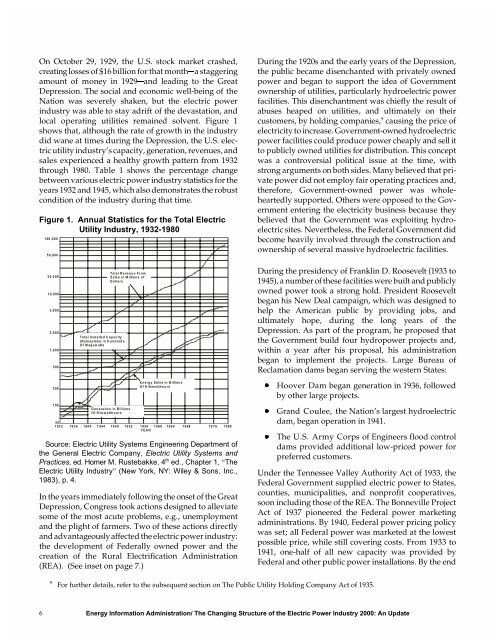The Changing Structure of the Electric Power Industry 2000: An ... - EIA
The Changing Structure of the Electric Power Industry 2000: An ... - EIA
The Changing Structure of the Electric Power Industry 2000: An ... - EIA
You also want an ePaper? Increase the reach of your titles
YUMPU automatically turns print PDFs into web optimized ePapers that Google loves.
On October 29, 1929, <strong>the</strong> U.S. stock market crashed,<br />
creating losses <strong>of</strong> $16 billion for that month�a staggering<br />
amount <strong>of</strong> money in 1929�and leading to <strong>the</strong> Great<br />
Depression. <strong>The</strong> social and economic well-being <strong>of</strong> <strong>the</strong><br />
Nation was severely shaken, but <strong>the</strong> electric power<br />
industry was able to stay adrift <strong>of</strong> <strong>the</strong> devastation, and<br />
local operating utilities remained solvent. Figure 1<br />
shows that, although <strong>the</strong> rate <strong>of</strong> growth in <strong>the</strong> industry<br />
did wane at times during <strong>the</strong> Depression, <strong>the</strong> U.S. electric<br />
utility industry’s capacity, generation, revenues, and<br />
sales experienced a healthy growth pattern from 1932<br />
through 1980. Table 1 shows <strong>the</strong> percentage change<br />
between various electric power industry statistics for <strong>the</strong><br />
years 1932 and 1945, which also demonstrates <strong>the</strong> robust<br />
condition <strong>of</strong> <strong>the</strong> industry during that time.<br />
Figure 1. <strong>An</strong>nual Statistics for <strong>the</strong> Total <strong>Electric</strong><br />
Utility <strong>Industry</strong>, 1932-1980<br />
6<br />
100,000<br />
50,000<br />
20,000<br />
10,000<br />
5,000<br />
2,000<br />
1,000<br />
500<br />
200<br />
100<br />
Total Installed Capacity<br />
(Nameplate) in Hundreds<br />
Of Megawatts<br />
Total Revenue From<br />
Sales in Millions <strong>of</strong><br />
Dollars<br />
Generation in Billions<br />
Of Kilowatthours<br />
Energy Sa les in Billions<br />
Of Kilowatthours<br />
50<br />
1932 1936 1940 1944 1948 1952 1956 1960 1964 1968 1976 1980<br />
YEAR<br />
Source: <strong>Electric</strong> Utility Systems Engineering Department <strong>of</strong><br />
<strong>the</strong> General <strong>Electric</strong> Company, <strong>Electric</strong> Utility Systems and<br />
Practices, ed. Homer M. Rustebakke, 4 th ed., Chapter 1, “<strong>The</strong><br />
<strong>Electric</strong> Utility <strong>Industry</strong>” (New York, NY: Wiley & Sons, Inc.,<br />
1983), p. 4.<br />
In <strong>the</strong> years immediately following <strong>the</strong> onset <strong>of</strong> <strong>the</strong> Great<br />
Depression, Congress took actions designed to alleviate<br />
some <strong>of</strong> <strong>the</strong> most acute problems, e.g., unemployment<br />
and <strong>the</strong> plight <strong>of</strong> farmers. Two <strong>of</strong> <strong>the</strong>se actions directly<br />
and advantageously affected <strong>the</strong> electric power industry:<br />
<strong>the</strong> development <strong>of</strong> Federally owned power and <strong>the</strong><br />
creation <strong>of</strong> <strong>the</strong> Rural Electrification Administration<br />
(REA). (See inset on page 7.)<br />
During <strong>the</strong> 1920s and <strong>the</strong> early years <strong>of</strong> <strong>the</strong> Depression,<br />
<strong>the</strong> public became disenchanted with privately owned<br />
power and began to support <strong>the</strong> idea <strong>of</strong> Government<br />
ownership <strong>of</strong> utilities, particularly hydroelectric power<br />
facilities. This disenchantment was chiefly <strong>the</strong> result <strong>of</strong><br />
abuses heaped on utilities, and ultimately on <strong>the</strong>ir<br />
customers, by holding companies, 9 causing <strong>the</strong> price <strong>of</strong><br />
electricity to increase. Government-owned hydroelectric<br />
power facilities could produce power cheaply and sell it<br />
to publicly owned utilities for distribution. This concept<br />
was a controversial political issue at <strong>the</strong> time, with<br />
strong arguments on both sides. Many believed that private<br />
power did not employ fair operating practices and,<br />
<strong>the</strong>refore, Government-owned power was wholeheartedly<br />
supported. O<strong>the</strong>rs were opposed to <strong>the</strong> Government<br />
entering <strong>the</strong> electricity business because <strong>the</strong>y<br />
believed that <strong>the</strong> Government was exploiting hydroelectric<br />
sites. Never<strong>the</strong>less, <strong>the</strong> Federal Government did<br />
become heavily involved through <strong>the</strong> construction and<br />
ownership <strong>of</strong> several massive hydroelectric facilities.<br />
During <strong>the</strong> presidency <strong>of</strong> Franklin D. Roosevelt (1933 to<br />
1945), a number <strong>of</strong> <strong>the</strong>se facilities were built and publicly<br />
owned power took a strong hold. President Roosevelt<br />
began his New Deal campaign, which was designed to<br />
help <strong>the</strong> American public by providing jobs, and<br />
ultimately hope, during <strong>the</strong> long years <strong>of</strong> <strong>the</strong><br />
Depression. As part <strong>of</strong> <strong>the</strong> program, he proposed that<br />
<strong>the</strong> Government build four hydropower projects and,<br />
within a year after his proposal, his administration<br />
began to implement <strong>the</strong> projects. Large Bureau <strong>of</strong><br />
Reclamation dams began serving <strong>the</strong> western States:<br />
9 For fur<strong>the</strong>r details, refer to <strong>the</strong> subsequent section on <strong>The</strong> Public Utility Holding Company Act <strong>of</strong> 1935.<br />
Energy Information Administration/ <strong>The</strong> <strong>Changing</strong> <strong>Structure</strong> <strong>of</strong> <strong>the</strong> <strong>Electric</strong> <strong>Power</strong> <strong>Industry</strong> <strong>2000</strong>: <strong>An</strong> Update<br />
� Hoover<br />
� Grand<br />
� <strong>The</strong><br />
Dam began generation in 1936, followed<br />
by o<strong>the</strong>r large projects.<br />
Coulee, <strong>the</strong> Nation’s largest hydroelectric<br />
dam, began operation in 1941.<br />
U.S. Army Corps <strong>of</strong> Engineers flood control<br />
dams provided additional low-priced power for<br />
preferred customers.<br />
Under <strong>the</strong> Tennessee Valley Authority Act <strong>of</strong> 1933, <strong>the</strong><br />
Federal Government supplied electric power to States,<br />
counties, municipalities, and nonpr<strong>of</strong>it cooperatives,<br />
soon including those <strong>of</strong> <strong>the</strong> REA. <strong>The</strong> Bonneville Project<br />
Act <strong>of</strong> 1937 pioneered <strong>the</strong> Federal power marketing<br />
administrations. By 1940, Federal power pricing policy<br />
was set; all Federal power was marketed at <strong>the</strong> lowest<br />
possible price, while still covering costs. From 1933 to<br />
1941, one-half <strong>of</strong> all new capacity was provided by<br />
Federal and o<strong>the</strong>r public power installations. By <strong>the</strong> end

















